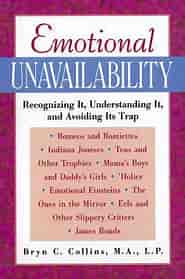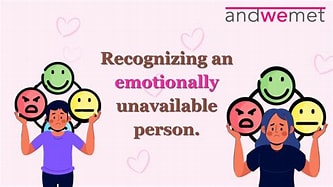Recognizing Emotional Unavailability
Introduction
Have you ever felt like you were pouring your heart out to someone, only to be met with a blank stare or a distant nod? It’s frustrating, isn’t it? Emotional unavailability can be a significant barrier in relationships, leaving one partner feeling isolated and misunderstood. But what does it really mean to be emotionally unavailable? And more importantly, how can you bridge that gap and foster a deeper connection with your partner? In this article, we’ll explore the signs of emotional unavailability, its causes, and practical strategies to connect more effectively with your partner.
What is Emotional Unavailability?
Emotional unavailability refers to a person’s inability or unwillingness to engage in emotional intimacy. This can manifest in various ways, such as avoiding deep conversations, shutting down during conflicts, or being unable to express feelings. It’s not always intentional; sometimes, it stems from past traumas or fear of vulnerability.

Signs of Emotional Unavailability
Recognizing emotional unavailability can be tricky. Here are some common signs to look out for:
- Avoidance of Deep Conversations: If your partner consistently steers clear of discussions about feelings or future plans, it could indicate emotional unavailability.
- Limited Emotional Expression: A partner who rarely shares their emotions or seems indifferent may struggle with emotional intimacy.
- Fear of Commitment: If your partner hesitates to define the relationship or make long-term plans, they might be emotionally unavailable.
- Inconsistent Communication: Frequent changes in how often they reach out can signal mixed feelings or reluctance to connect deeply.
The Impact of Emotional Unavailability on Relationships
Emotional unavailability can create a rift between partners. When one person craves connection and the other is emotionally distant, it leads to frustration and disappointment. Over time, this dynamic can erode trust and intimacy, leaving both partners feeling unfulfilled.
How It Affects Communication
Effective communication is the backbone of any relationship. When one partner is emotionally unavailable, it can lead to misunderstandings and resentment. You might feel like you’re talking to a wall when you’re trying to share your thoughts and feelings.
The Cycle of Frustration
This lack of connection often leads to a cycle where the emotionally available partner feels neglected and may start withdrawing themselves. It’s a vicious cycle that can spiral out of control if not addressed.

Understanding the Causes of Emotional Unavailability
To tackle emotional unavailability effectively, it helps to understand its roots. Here are some common causes:
Past Trauma
Many individuals who struggle with emotional availability have experienced trauma in their past relationships. This could include abandonment issues, betrayal, or loss. These experiences can lead them to build walls around their emotions as a protective measure.
Fear of Vulnerability
Being vulnerable requires courage. Some people fear that opening up will make them susceptible to hurt or rejection. This fear can prevent them from forming deep connections.

Attachment Styles
Attachment theory suggests that our early relationships with caregivers shape how we connect with others later in life. Those with avoidant attachment styles may find it challenging to engage emotionally in adult relationships.
Strategies for Connecting with an Emotionally Unavailable Partner
Now that we’ve explored what emotional unavailability is and its causes let’s dive into some practical strategies for connecting with your partner.
1. Foster Open Communication
Creating an environment where both partners feel safe expressing their feelings is crucial. Start small—share your thoughts and encourage your partner to do the same without judgment.
Tips for Effective Communication:
- Use “I” statements instead of “you” statements (e.g., “I feel neglected when we don’t talk” vs. “You never talk to me”).
- Listen actively without interrupting.
- Validate their feelings even if you don’t fully understand them.
2. Be Patient
Building emotional intimacy takes time—especially if your partner has been emotionally unavailable for a while. Patience is key; don’t rush them into opening up before they’re ready.
3. Encourage Vulnerability
Lead by example! Share your own vulnerabilities and fears; this might encourage your partner to do the same. Show them that being open about emotions doesn’t have to be scary.
4. Create Shared Experiences
Engaging in activities together can help strengthen your bond. Whether it’s cooking dinner together, going on hikes, or exploring new hobbies, shared experiences foster connection and intimacy.
5. Seek Professional Help
Sometimes, the issues at play are too complex for couples to resolve alone. Seeking help from a therapist can provide valuable insights and tools for navigating emotional barriers together.
When Is It Time to Walk Away?
While striving for connection is important, there may come a time when you need to consider whether the relationship is worth pursuing. Here are some signs that it might be time to reevaluate:
Persistent Patterns of Avoidance
If your partner consistently avoids emotional discussions despite your efforts, it may indicate a deeper unwillingness to change.
Emotional Exhaustion
Feeling drained from constantly trying to connect without reciprocation? It’s essential to prioritize your own mental health as well.
Lack of Effort from Your Partner
If you notice that only one person is putting in the work while the other remains distant, it might be time for an honest conversation about the future of the relationship.
Conclusion
Navigating a relationship with an emotionally unavailable partner can feel like walking through a fog—challenging and disorienting at times. However, understanding the signs and causes of emotional unavailability equips you with the tools needed for connection. By fostering open communication, encouraging vulnerability, and being patient, you can create a space where both partners feel safe exploring their emotions together.
Remember that every relationship is unique; what works for one couple may not work for another. Ultimately, prioritizing mutual respect and understanding will guide you toward deeper intimacy—whether that leads you closer together or helps you recognize when it’s time to part ways.
FAQs
1. What are some common signs that my partner may be emotionally unavailable?
Common signs include avoidance of deep conversations, limited emotional expression, fear of commitment, and inconsistent communication patterns.
2. Can emotional unavailability change over time?
Yes! With effort from both partners—such as open communication and professional help—emotional availability can improve over time.
3. How can I encourage my partner to open up emotionally?
Fostering an environment of trust through active listening and sharing your own vulnerabilities can encourage your partner to express their feelings more openly.
4. Is it possible for an emotionally unavailable person to have healthy relationships?
While challenging, it is possible for emotionally unavailable individuals to have healthy relationships if they are willing to work on their issues and communicate openly with their partners.
5. When should I consider ending the relationship due to emotional unavailability?
Consider ending the relationship if there are persistent patterns of avoidance, emotional exhaustion on your part, or lack of effort from your partner despite attempts at connection.


